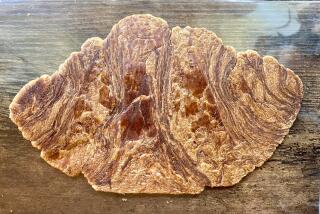Lattice Tops for Pie Crusts Come in Many Easy-to-Fashion Variations
- Share via
A lattice top allows the filling to peek through and is particularly attractive for cherry or berry pies. To make a plain lattice, half the strips are placed over the pie, then the remaining strips are simply placed at right angles over the top. Variations include twisting or weaving the strips, or placing them diagonally.
Whatever method used, you’ll need to prepare enough pastry for a double-crust pie. Roll out half the dough and fit into a pie plate (as directed in past Back To Basics columns) leaving a one-inch overhang.
Roll out the remaining dough and cut into 10 to 14 (one-half-inch wide) lattice strips. Use a ruler to guide a sharp knife for plain strips, a pastry wheel to cut strips with pinked edges (Step 1).
Add the filling to pie plate, then place five to seven of the strips, depending on the size of the pie, over the filling and about three-quarters-inch apart. For a woven lattice, lift or fold back alternate strips and weave another strip across those left unfolded (Step 2). Repeat the procedure, lifting or folding back alternate strips each time a cross-strip is added.
When the lattice is complete, trim the strips (Step 3), moisten with water or milk and attach to the edge of the pie, allowing a little leeway for shrinkage. Fold the overhang either over or under, building up a high edge that rests firmly on the rim of the pie plate and flute as desired.
Brushing the lattice with beaten egg (Step 4) will impart color and gloss as it bakes. The egg may be mixed with water or milk if desired. Some sources suggest an alternative of sprinkling the lattice with a tablespoon of sugar. Bake the completed pie as directed in the recipe.
PASTRY FOR DOUBLE-CRUST PIE
2 cups flour
1 teaspoon salt, optional
3/4 cup shortening or 2/3 cup lard
4 to 5 tablespoons ice water
Combine flour and salt in medium bowl. Place shortening on top, then using pastry blender, cut shortening into flour until particles are about size of small peas or coarse meal. Use relaxed flick of wrist to keep dough mixture from becoming compact mass. If necessary, run finger across inside arc of pastry blender to release shortening.
Sprinkle cold water, 1 tablespoon at time, over flour-shortening mixture, tossing lightly with fork to distribute liquid evenly. As water is added, flour-shortening mixture will begin to hold together.
Mix only enough so dough sticks together, overmixing results in tough crust. When too much liquid is added, pastry becomes sticky; too little liquid and pastry will be crumbly. When correct amount of water has been added, form pastry into ball using hands. Roll out immediately or chill from 30 minutes to 2 days.
Suggestions for column topics may be sent to Back to Basics, Food Section, The Times, Times Mirror Square, Los Angeles 90053.


